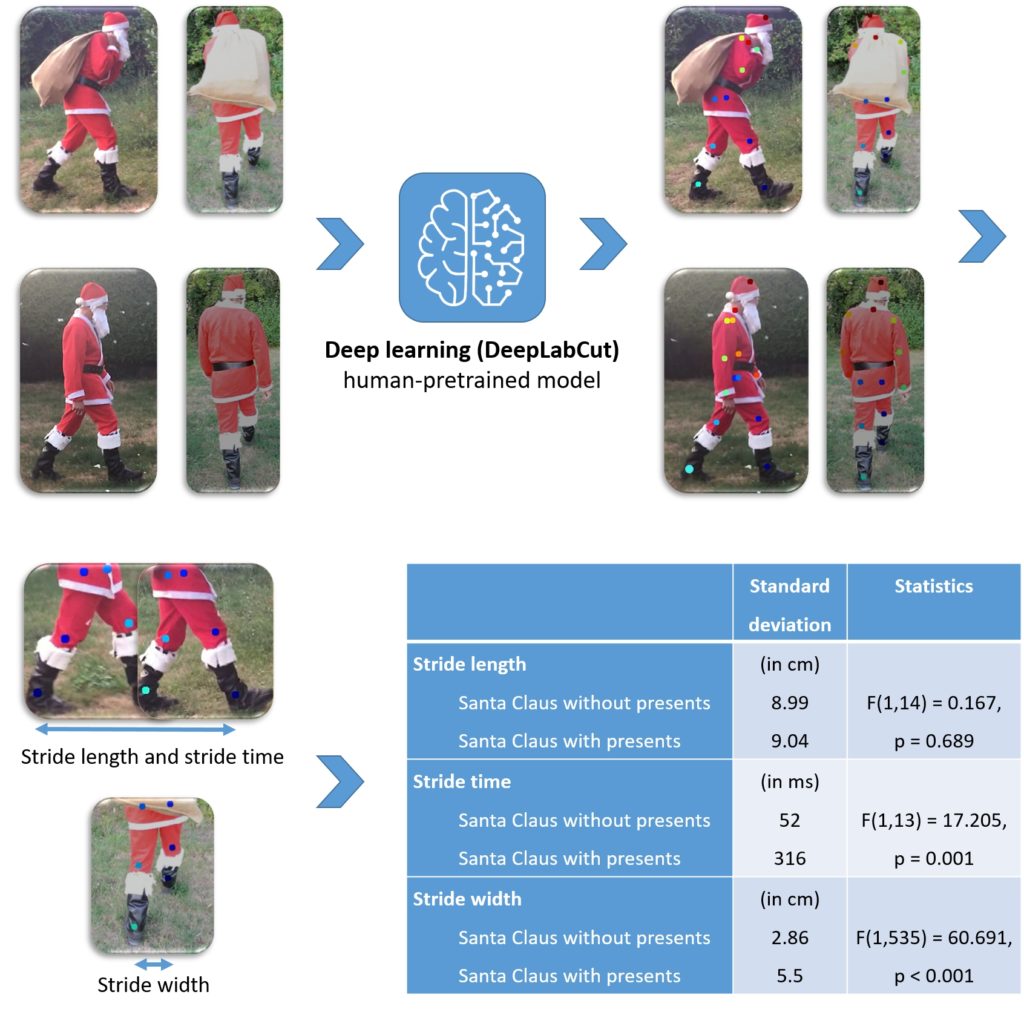By Maud van den Bogaart
Falls are a major cause of injury and death in older people (1). Based on his appearance, and according to common belief, Santa Claus has been estimated to be around 1750 years of age. Extrapolating the known relationship between age and fall risk, Santa Claus should have an extremely high risk of falling, which is aggravated by his night shift work under winter conditions. Additionally, carrying a load, such as a sack with presents, changes the gait pattern in a way that increases fall risk (2). A fall may preclude Santa from performing his annual chore and puts the happiness of millions of children at risk.
A sensitive parameter to detect fall risk is a person’s gait variability, defined as the stride-to-stride variations of gait kinematics. Indeed, older people at risk of falls are known to walk with increased gait variability compared to their counterparts with a lower fall risk (3). Unfortunately, to date, Santa’s natural habitat lacks a gait analysis setup to quantify his gait variability and assess his fall risk. Moreover, his busy schedule precludes a visit to a gait lab. Therefore, estimates of Santa’s fall risk are based on extrapolation and hence likely unreliable. New techniques based on deep learning, with a high degree of automatization, can assess gait variability in a natural environment from simple video-recordings (4). Using such novel methodology would allow to assess Santa in his natural habitat whilst not hampering his Christmas chores. This markerless method (DeepLabCut) has significant advantages over laboratory-based optoelectronic gait analysis, in that it is free, open-source, applicable in the participant’s natural environment, and requires only a video camera. Therefore, it is likely to be particularly useful for routine gait analysis in clinical settings.
Using DeepLabCut, we investigated Santa’s gait and gait variability, to assess his fall risk using a, presumably authentic, video we found on YouTube (Figure 1). In spite of his likely extremely old age, Santa’s gait variability puts him in a considerably younger age group, with values comparable to those of people between the age of 65 and 70 years old (2, 5). Hence, Santa’s gait variability and therefore fall risk could not be linearly extrapolated with age. Additionally, Santa adopted a different posture and increased gait variability when carrying presents, which was also similar to that of older people aged 65 –to 70 years (Figure 1). Carrying presents indeed increased Santa’s gait variability, which suggests a higher fall risk while making people merry during Christmas time (2).
In conclusion, we highly recommended Santa to train his strength, balance and gait stability before the Christmas season and, if possible, to spread the delivery of presents over a longer period to reduce his risk of falling. The use of deep learning to analyze gait in natural environments and clinical settings is very promising and I expect that it will revolutionize the field of rehabilitation medicine.

Figure 1. Workflow of the gait analysis of video-recordings of Santa Claus walking with and without a Christmas sack with presents in sagittal and frontal plane using deep learning (Deeplabcut; pretrained human gait model). Video-recordings of Santa Claus during one of his practice runs with and without a Christmas sack with presents were collected (https://youtu.be/U9eUqR7uXEE, https://youtu.be/Pbfp04UCMCs, https://youtu.be/phpm0AF3AO4, https://youtu.be/dvn5qujgrjE). The DeepLabCut human-pretrained model was used to retrieve the 2D locations of anatomical landmarks (e.g. ankle, knee, hip and shoulder) during walking (https://github.com/DeepLabCut/DeepLabCut/blob/master/examples/COLAB_DLC_ModelZoo.ipynb). Stride length, time and width were defined by the 2D locations of the ankle joint centers. Seven strides were analyzed per video. Differences in stride length, width and time variability between conditions were tested for significance using the Levene’s Test of Homogeneity of Variance (α=0.05).
References
- Haagsma JA, Graetz N, Bolliger I, Naghavi M, Higashi H, Mullany EC, et al. The global burden of injury: incidence, mortality, disability-adjusted life years and time trends from the Global Burden of Disease study 2013. Inj Prev. 2016;22(1):3-18.
- Walsh GS, Low DC, Arkesteijn M. Effect of stable and unstable load carriage on walking gait variability, dynamic stability and muscle activity of older adults. J Biomech. 2018;73:18-23.
- Callisaya ML, Blizzard L, Schmidt MD, McGinley JL, Srikanth VK. Ageing and gait variability–a population-based study of older people. Age Ageing. 2010;39(2):191-7.
- Nath T, Mathis A, Chen AC, Patel A, Bethge M, Mathis MW. Using DeepLabCut for 3D markerless pose estimation across species and behaviors. Nat Protoc. 2019;14(7):2152-76.
- Hollman JH, McDade EM, Petersen RC. Normative spatiotemporal gait parameters in older adults. Gait Posture. 2011;34(1):111-8.
About the Author

Maud van den Bogaart
Hasselt University (Belgium) and Vrije Universiteit Amsterdam (the Netherlands)
Maud is a joint degree PhD student at Hasselt University and the Vrije Universiteit Amsterdam. Her main research topic is Biomechanical fundamentals of balance control across the lifespan.
Copyright
© 2020 by the author. Except as otherwise noted, the ISPGR blog, including its text and figures, is licensed under a Creative Commons Attribution-ShareAlike 4.0 International License. To view a copy of this license, visit https://creativecommons.org/licenses/by-sa/4.0/legalcode.
ISPGR blog (ISSN 2561-4703)
Are you interested in writing a blog post for the ISPGR website? If so, please email the ISGPR Secretariat with the following information:
- First and Last Name
- Institution/Affiliation
- Paper you will be referencing


